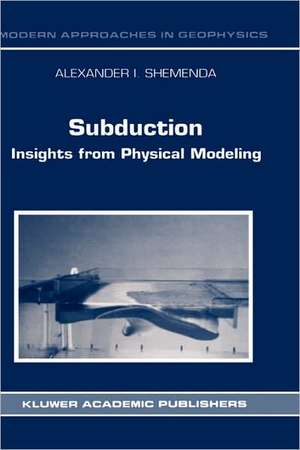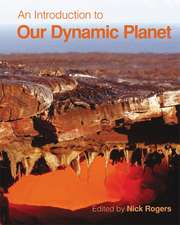Subduction: Insights from Physical Modeling: Modern Approaches in Geophysics, cartea 11
Autor Alexander I. Shemendaen Limba Engleză Hardback – 30 sep 1994
This work is for geologists and geophysicists interested in geodynamics of the convergent plate boundaries and in mechanics of the lithosphere.
| Toate formatele și edițiile | Preț | Express |
|---|---|---|
| Paperback (1) | 936.12 lei 6-8 săpt. | |
| SPRINGER NETHERLANDS – 10 oct 2012 | 936.12 lei 6-8 săpt. | |
| Hardback (1) | 947.50 lei 6-8 săpt. | |
| SPRINGER NETHERLANDS – 30 sep 1994 | 947.50 lei 6-8 săpt. |
Din seria Modern Approaches in Geophysics
- 18%
 Preț: 958.73 lei
Preț: 958.73 lei - 15%
 Preț: 642.36 lei
Preț: 642.36 lei - 18%
 Preț: 956.03 lei
Preț: 956.03 lei - 18%
 Preț: 947.98 lei
Preț: 947.98 lei - 18%
 Preț: 953.97 lei
Preț: 953.97 lei - 15%
 Preț: 640.06 lei
Preț: 640.06 lei - 15%
 Preț: 640.88 lei
Preț: 640.88 lei -
 Preț: 398.53 lei
Preț: 398.53 lei - 24%
 Preț: 784.02 lei
Preț: 784.02 lei - 18%
 Preț: 1384.75 lei
Preț: 1384.75 lei - 18%
 Preț: 950.84 lei
Preț: 950.84 lei - 15%
 Preț: 642.68 lei
Preț: 642.68 lei - 15%
 Preț: 642.51 lei
Preț: 642.51 lei -
 Preț: 392.75 lei
Preț: 392.75 lei - 18%
 Preț: 957.75 lei
Preț: 957.75 lei - 15%
 Preț: 643.34 lei
Preț: 643.34 lei - 15%
 Preț: 638.76 lei
Preț: 638.76 lei - 18%
 Preț: 956.33 lei
Preț: 956.33 lei - 18%
 Preț: 1228.62 lei
Preț: 1228.62 lei -
 Preț: 382.18 lei
Preț: 382.18 lei -
 Preț: 388.90 lei
Preț: 388.90 lei
Preț: 947.50 lei
Preț vechi: 1155.48 lei
-18% Nou
Puncte Express: 1421
Preț estimativ în valută:
181.31€ • 193.88$ • 151.17£
181.31€ • 193.88$ • 151.17£
Carte tipărită la comandă
Livrare economică 18 aprilie-02 mai
Preluare comenzi: 021 569.72.76
Specificații
ISBN-13: 9780792330424
ISBN-10: 0792330420
Pagini: 217
Ilustrații: XI, 217 p.
Dimensiuni: 155 x 235 x 14 mm
Greutate: 0.5 kg
Ediția:1994
Editura: SPRINGER NETHERLANDS
Colecția Springer
Seria Modern Approaches in Geophysics
Locul publicării:Dordrecht, Netherlands
ISBN-10: 0792330420
Pagini: 217
Ilustrații: XI, 217 p.
Dimensiuni: 155 x 235 x 14 mm
Greutate: 0.5 kg
Ediția:1994
Editura: SPRINGER NETHERLANDS
Colecția Springer
Seria Modern Approaches in Geophysics
Locul publicării:Dordrecht, Netherlands
Public țintă
ResearchCuprins
1. Similarity Criteria.- 1.1. Introduction.- 1.2. The general approach to physical similarity.- 1.3. Derivation of similarity criteria from the equations of continuum mechanics.- 1.4. Dilatant plasticity and brittle failure.- 1.5. Conclusions.- 2. Model Setting, Technique and Facilities.- 2.1. Introduction.- 2.2. General modeling scheme.- 2.3. Model materials.- 2.4. Experimental installation and technique.- 3. Initiation and Development of Subduction Under Horizontal Compression of the Lithosphere.- 3.1. Introduction.- 3.2. Results of the experiments.- 3.3. Analysis of experimental results.- 3.4. Formation of a subduction zone in a homogeneous oceanic lithosphere.- 3.5. Initiation of a subduction zone on an old inclined fault.- 3.6. Strain and stress in the subducting plate.- 3.7. Estimation of pressure between the plates in the subduction zone.- 3.8. Elastico-plastic bending of the subducting plate, its yield limit and modulus of elasticity.- 3.9. Conclusions.- 4. Relationship Between Subduction Regime and Back Arc Dynamics.- 4.1. Introduction.- 4.2. Experimental results.- 4.3. Hydrostatic suction of the plates.- 4.4. Stress in the overriding plate due to subduction of an old (dense) lithosphere.- 4.5. Other mechanisms for tension in the overriding plate.- 4.6. Influence of crustal thickness and density of the overriding plate on its stress state.- 4.7. Geodynamic interpretation of modeling results.- 4.8. The location of back arc rifting.- 4.9. Relationship of the back arc regime to relief and the gravity field in subduction zones.- 4.10. Benioff zone dip angle and back arc regime.- 4.11. On the cyclicity of back arc tension and compression.- 4.12. Vertical movements in subduction zones.- 4.13. On causes of the arcuate configuration of subduction zones.- 4.14. Relationof seismicity in the subduction zone with back arc dynamics.- 4.15. On the mechanism of back arc tension in some particular subduction zones.- 4.16. South-Sandwich subduction zone.- 4.17. Possible mechanism for evolution of the Scotia Sea region.- 4.18. The Aegean region.- 4.19. Conclusions.- 5. Jumps of Subduction Zones, Subduction Reversal, and Closing of Back Arc Basins.- 5.1. Introduction.- 5.2. Location of the lithospheric failure and jump of subduction zone.- 5.3. Mechanism for lithospheric failure and polarity of a new subduction zone.- 5.4. Deformation of the overriding plate in the Kuril subduction zone.- 5.5. Subduction of the continental margin: arc-continent collision in Taiwan.- 5.6. Conclusions.- 6. Continental Subduction.- 6.1. Introduction.- 6.2. Modeling approach.- 6.3. Similarity criteria and the model materials.- 6.4. Experimental results.- 6.5. Analysis of the results.- 6.6. Concluding remarks and possible application of the results to the India-Eurasia collision.- References.- Notations.










